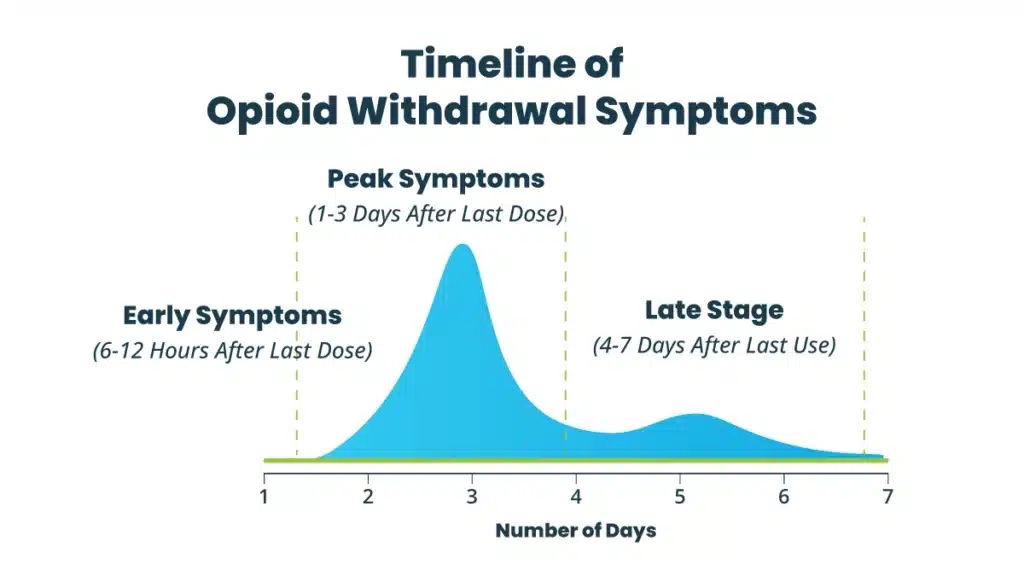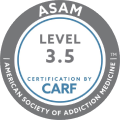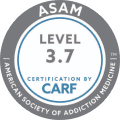In the journey to overcome opioid addiction, many wonder, “How long do opioid withdrawal symptoms last?” This concern is common among those seeking recovery. The duration and severity of withdrawal symptoms can vary from one person to another based on several factors.
Opioid withdrawal symptoms typically begin within hours after the last dose and peak within one to three days. However, some symptoms, like cravings and mood disturbances, may persist for weeks or even months. Read on as we explore the general opioid withdrawal timeline.
Key Takeaways
Understanding the duration and intensity of opioid withdrawal is vital for individuals seeking recovery from addiction. This article covers:
- Opioid withdrawal unfolds in different stages, each with its own set of symptoms and complications.
- Various factors, such as the type and potency of opioids, affect the overall duration of opioid withdrawal.
- Effective treatment approaches are available to help individuals safely navigate the complexity of withdrawal.
Take the initial step towards recovery from substance use disorder (SUD) by seeking professional help at The Haven Detox-South Florida. Dial (561) 328-8627 for detailed information!

Timeline of Opioid Withdrawal Symptoms
Opioid withdrawal is a challenging experience marked by a series of physical and psychological symptoms that occur when someone suddenly reduces or stops using opioids after prolonged use.
Here’s a breakdown of the typical opioid timeline:
Early Symptoms (6-12 Hours After Last Dose)
During the early stage of opioid withdrawal, individuals may start to experience mild to moderate symptoms as the drug begins to leave their system. These symptoms usually begin within 6 to 12 hours after the last dose and may include:
- Agitation
- Anxiety
- Muscle aches
- Insomnia
- Sweating
- Runny nose
- Yawning
- Increased tearing
- Dilated pupils
- Abdominal cramps
- Nausea
- Vomiting
- Diarrhea
Peak Symptoms (1-3 Days After Last Dose)
The peak of opioid withdrawal symptoms typically occurs within 1-3 days after the last dose as the body struggles to readjust to functioning without the drug. Symptoms during this stage may intensify and include:
- Intense cravings for opioids
- Increased severity of early symptoms
- Goosebumps
- Tremors
- Rapid heartbeat
- High blood pressure
- Dilated pupils
- Increased body temperature
- Restlessness
- Irritability
- Depression
- Difficulty concentrating
Late Stage (4-7 Days After Last Use)
In the late stage of opioid withdrawal, symptoms gradually begin to taper off, although some may persist or fluctuate in intensity. Common symptoms during this stage include:
- Nausea and vomiting may continue
- Muscle aches and pains
- Cravings may still be strong
- Insomnia or disturbed sleep patterns
- Anxiety and depression may persist
- Emotional instability
- Fatigue
Post-Acute Withdrawal Syndrome (PAWS)
For some individuals, especially those with a medical history of long-term opioid use, symptoms of withdrawal may persist beyond the acute phase, a condition known as post-acute withdrawal syndrome (PAWS). PAWS can last for weeks, months, or even years and may include symptoms such as:
- Persistent cravings
- Mood swings
- Anxiety
- Depression
- Irritability
- Fatigue
- Sleep disturbances
- Difficulty concentrating
- Memory problems
- Reduced ability to experience pleasure (Anhedonia)
- Physical symptoms such as gastrointestinal distress or muscle aches
Remember, not everyone experiences all of these symptoms, and the intensity can vary significantly from person to person. Seeking medical attention and support during opioid and opiate withdrawal is vital for managing symptoms effectively.
Factors Influencing Opioid Withdrawal Duration
Opioid withdrawal duration can vary based on several factors, influencing how long it takes for someone to overcome the withdrawal symptoms. Here are some common contributing factors:
Type Of Opioid
Different opioids have different half-lives and potencies, leading to variations in withdrawal duration and intensity. Short-acting opioids like heroin typically produce more intense but shorter withdrawal symptoms compared to long-acting opioids like methadone.
Duration And Frequency Of Use
The length of time a person has been using opioids and how frequently they use them can also impact the duration of withdrawal. Individuals who have been using opioid drugs for a long time or at high frequencies may experience more prolonged and intense withdrawal symptoms.
Dosage
The dosage of opioids consumed also plays a role in withdrawal duration. High doses can lead to more severe withdrawal symptoms, while lower doses may result in a shorter and less intense withdrawal period.
Individual Physiology
Genetics, overall health, metabolism, and other individual factors can influence how the body responds to opioid withdrawal. Some individuals may experience more intense or prolonged withdrawal symptoms due to these factors.
Polydrug Use
The use of multiple substances, such as opioids, in conjunction with other drugs or alcohol can complicate the withdrawal process and prolong symptoms. Polydrug use may exacerbate withdrawal symptoms and require specialized treatment approaches.
Co-Occurring Health Conditions
Existing health issues can impact the severity and duration of opioid withdrawal. Mental health disorders, severe pain, and other medical conditions may intensify withdrawal symptoms and require tailored treatment approaches.
Environmental Factors
Social support, living environment, access to healthcare, and stress levels can all influence the duration and severity of opioid withdrawal. A supportive and stable environment can aid in recovery and potentially shorten the duration of withdrawal.
Support And Treatment
Access to comprehensive support and treatment services, including medication-assisted treatment (MAT) and counseling, can significantly shorten the duration of opioid withdrawal and improve overall recovery outcomes.
Remember, the individual experiences with opioid withdrawal can vary widely, and the presence of multiple factors may interact to influence the duration and severity of symptoms.
Managing Opioid Withdrawal Symptoms
When facing the symptoms of opioid withdrawal, it’s essential to know that there are effective strategies available to help individuals cope and navigate through this challenging time.
Medical Detoxification
Medical detoxification, conducted under the supervision of healthcare professionals, involves safely tapering off opioid drugs while managing withdrawal symptoms. This process may include the use of medications in order to alleviate symptoms and ensure the safety and comfort of the individual undergoing this critical phase of recovery.
Medication-Assisted Treatment (MAT)
Medication-assisted-Treatment (MAT) involves the use of medications approved by the United States Food and Drug Administration (FDA) alongside behavioral therapies and counseling sessions to support recovery from opioid dependence. These MAT medicines can help reduce cravings, prevent relapse, and stabilize individuals during the withdrawal process and beyond.
Behavioral Therapies
Behavioral therapies, such as cognitive-behavioral therapy (CBT) and contingency management (CM), address the psychological aspects of opioid addiction and withdrawal. These proven therapies help individuals develop coping skills, identify triggers for substance abuse, and modify unhealthy thought patterns and behaviors associated with addiction.
Support Groups
Local addiction support groups, such as Narcotics Anonymous (NA) or SMART Recovery, offer a safe place to receive invaluable peer support and encouragement during the withdrawal and recovery process. Sharing experiences, insights, and strategies with others who have faced similar challenges can foster a sense of belonging and motivation to stay on the track to sobriety.
Self-Care Strategies
In addition to professional treatments and support, self-care strategies can help individuals manage the adverse effects of opioid addiction and promote overall well-being. These strategies may include maintaining a healthy diet, staying hydrated, exercising regularly, practicing stress management techniques such as deep breath exercises or meditation, and engaging in activities that bring joy and fulfillment.
By combining these approaches, individuals can effectively manage withdrawal symptoms, lessen the risk of relapse, and build a strong foundation for a healthier, substance-free life.
Frequently Asked Questions (FAQs)
What happens when you stop taking a drug?
When you stop taking a drug after long-term use, your body may experience withdrawal symptoms as it adjusts to the absence of the substance. These symptoms can include physical discomforts like nausea, sweating, and muscle aches, as well as psychological effects such as anxiety or depression.
The severity and length of these withdrawal symptoms vary depending on various factors like the type of drug, how long it was used, and individual differences. Seeking support from healthcare professionals and utilizing coping strategies can help manage withdrawal symptoms effectively.
How long after stopping opioids do the withdrawal symptoms usually begin?
Withdrawal symptoms from opioids typically begin within 6 to 12 hours after the last dose, peaking around 1 to 3 days and gradually subsiding over 5 to 7 days. However, the exact onset and duration can vary depending on factors like the type of opioid, dosage, duration of use, and individual physiology.
Common symptoms may include cravings, anxiety, agitation, muscle aches, nausea, vomiting, diarrhea, sweating, and insomnia. Seeking medical support and possibly tapering off opioids under supervision can help manage withdrawal symptoms and increase the chances of successful recovery.
How long do Suboxone and opioid withdrawals last?
The duration and severity of Suboxone and opioid withdrawals can vary depending on factors such as the individual’s physiology, the frequency and duration of opioid use, and the specific substances involved.
Generally, acute withdrawal symptoms from opioids, including Suboxone, peak within the first 72 hours and may last up to a week or more. However, some symptoms, like cravings and mood swings, can persist for weeks or even months.
It is essential for individuals undergoing withdrawal from opioids to seek support from medical professionals or addiction specialists who can provide proper care and guidance throughout the process.
Discover Renewal At The Haven Detox-South Florida
Struggling with opioid use disorder (OUD) can feel overwhelming, but there is hope for a brighter tomorrow. At The Haven Detox-South Florida, we’re here to support you on your journey to recovery.
Starting with our medical detox program, we help your body eliminate harmful toxins in a safe and controlled environment. From there, our inpatient rehab program provides 24/7 intensive care to guide you toward lasting recovery.
During treatment, our patients experience an effective balance of proven therapies, appropriate medications, NAD IV therapy, and holistic approaches to address both the physical and emotional aspects of their addiction.
Don’t wait any longer to take the important first step towards a better future. Contact us today at (561) 328-8627, and let us help you reclaim your life from drug use disorder.








